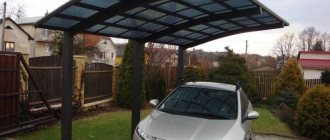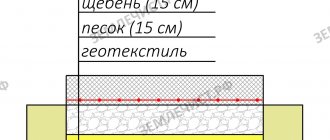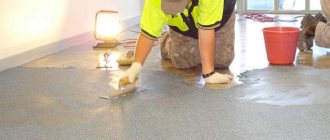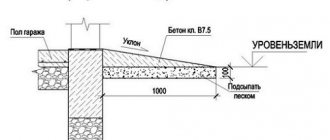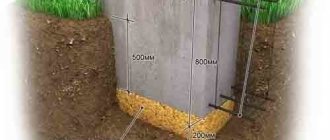Concrete is one of the most common building materials with high strength and durability. The main components of the concrete mixture are: cement, water and fillers in the form of sand, crushed stone, gravel, expanded clay, pebbles or other fractional materials. The quality of concrete directly depends on the ratio of components, thorough mixing and compaction during placement. To avoid possible defects, all technologies must be strictly followed.
Concreting stages
- Preparation for pouring concrete is a set of works aimed at preparing an object for concreting. For example, pouring concrete into the ground requires excavation of soil, creation of a sand cushion and reinforcement, and arrangement of formwork.
- Direct laying of concrete mixture. It is carried out in accordance with the project, using different methods, depending on weather conditions and the characteristics of the object. The rules for pouring concrete are aimed at ensuring the strength, reliability, durability of concrete structures, as well as consumer safety.
- Caring for concrete after pouring. The list of such works includes compacting the poured mixture and providing conditions for its high-quality hardening.
Pouring a strip foundation for a fence with metal posts
A strong, beautiful fence on a monolithic base is a decoration for any property. How to properly pour concrete into a shallow strip foundation is a proven technology. Unlike a columnar foundation, a linear foundation better withstands the sailing loads of a continuous plane, dynamic from heavy fragments of a stone or brick fence.
When choosing the type of fence, we consider:
- a massive fence made of stones requires a foundation installed 20 cm below the freezing depth.
- A fence made of solid corrugated sheet will be stable on a monolith up to 80 cm deep.
- Brick pillars, fence, corrugated sheets or metal rods - strips 30 cm wide are enough.
Removable formwork is installed in the prepared trench. If a base is not needed, the foundation is shallow, formwork can be omitted, but reinforcement and waterproofing must be done. In a shallow foundation, the holes under the support pillars are further deepened manually or with a drill.
To install simultaneously buried supports in the foundation body, concreting is carried out in 2 stages. First, reinforcement is installed around iron poles made of thick-walled pipes. The pipes are first coated from the inside against corrosion, and the hole is covered with film. Only the pipes are concreted to the level of the bottom of the common tape and kept until hardened. Only then does the tape continue to be poured.
The reinforcement frame is made by welding, reinforcing wire with a cross-section of 10 mm is used, 10 cm away from the foundation walls. For pouring under a heavy frame, concrete M250 or M300 is used.
Filling the entire trench is done in one step. When laying, concrete is compacted by piercing the mixture with pins to allow air to escape. After pouring, the mixture is leveled and covered with a film to prevent moisture evaporation. The construction of the fence continues after a month.
Laying concrete in different weather conditions
The technology for laying concrete depends on the weather conditions and the season in which it is carried out. Let's look at how concrete should be poured in hot, cool weather and sub-zero temperatures.
Laying concrete in the heat
The main difficulty of this process is that high temperature and low humidity of the surrounding air lead to excessively rapid hardening of concrete. This negatively affects the strength characteristics of artificial stone and structures made from it. Therefore, pouring concrete in hot weather must be carried out with strict adherence to the order and timing of the stages of the technological process.
When pouring concrete in hot weather, the following requirements must be met:
- Use good waterproofing. The requirement must be met even when the structure being created, according to the design, is not waterproof. This is done to prevent moisture from the concrete from being absorbed into the soil. Thanks to this, the solution gradually hardens.
- Prompt unloading of concrete from a concrete mixer (concrete truck). It has sufficient frost resistance, which makes it widely in demand for creating facilities operated in variable climate conditions. This type of concrete is characterized by endurance and durability.
- Effective organization of concrete supplies in the case of using several concrete mixers. In such conditions, it is necessary to coordinate the arrival time of concrete trucks so that they do not stand idle waiting for unloading. Such forethought will make the construction process uniform and continuous, and it also ensures the preservation of the high quality of concrete used in the work.
Placing concrete in cool weather and rain
The weather is characterized by low temperatures and high humidity. Such conditions lead to the fact that the poured solution hardens much longer than at optimal humidity and temperature parameters. Therefore, builders are forced to wait quite a long time before starting to grout the concrete surface. This does not deteriorate the quality of concrete structures, but significantly increases the time for construction and finishing operations.
Pouring concrete in wet and cool weather should be carried out taking into account the following requirements:
- Concrete waterproofing should only be used if required by the project. To speed up the hardening process of concrete, waterproofing should not be used at all, especially when concreting inclined surfaces.
- Concrete moisture should not be excessive. To protect the surface of the mixture from rain, it should be protected with a canopy or special film.
- Pouring the foundation with concrete layer by layer must be carried out in a timely manner.
Pouring concrete in cold weather
There are special rules for carrying out concrete work in winter conditions. Concrete has an important property. As the concrete hardens, the temperature increases. Heat is released as a result of the so-called exothermic reaction between cement and water. This valuable property of the concrete mixture helps builders protect concrete from rapid freezing.
At negative temperatures, the hardening process of the concrete mixture is disrupted: the water in it freezes and turns into ice, normal interaction between cement and water does not occur, which means the amount of heat generated by the cement during hardening is reduced. When frozen concrete is warmed up, the hardening process resumes, but still the strength of the concrete decreases slightly.
In order for concrete to withstand the damaging effects of frost, it must reach 50% of its design strength before freezing. Then the grains of the fillers will be firmly attached to each other, and when water turns into ice, it will not be able to tear them away from each other.
When concreting and further hardening of concrete, it is necessary to maintain a constant positive temperature of the external environment until the required strength is achieved. To prevent freezing of the concrete mixture and create normal conditions for its hardening, various methods of winter concreting are used. The thermos method, steam heating, electric heating, and portable heat guns have become widespread. Concrete must be delivered to the work site warm, and the sand and crushed stone cushion must not be frozen.
When making a concrete mixture, it is necessary to use warm water and inert materials heated to positive temperatures. Using the UBRS-10, UBRS-40 installations in the “winter version” configuration for concrete production in winter allows you to avoid many problems and obtain guaranteed quality construction mixtures.
Pros and cons of pouring
The advantage of concrete is the strength and durability of structures built from it.
Concrete floors and walls have many advantages, which allows the material to be used in the construction of residential and industrial premises. This is due to the following advantages of the building material:
- high structural strength;
- ease of filling;
- durability of the structure;
- low cost of materials;
- low hygroscopicity;
- environmental Safety.
The only disadvantage of a concrete structure is the feeling of cold when touched. This drawback can be eliminated by insulating the wall or floor with polystyrene foam. In addition, premature destruction of the concrete coating indicates the low quality of raw materials when preparing the mixture, which is why experienced builders use factory-made concrete.
Compacting poured concrete
During the process of mixing in a concrete mixer and pouring, the concrete solution is saturated with air bubbles. In addition, during operation such material may lose its uniformity. To eliminate these shortcomings, special devices are used for compacting concrete - vibrators. They affect the poured mixture with vibration, which leads to the removal of air bubbles and voids from the thickness of the concrete. Vibration also contributes to the uniform distribution of material particles throughout its thickness, which gives the concrete solidity and homogeneity.
When to pour in layers?
To carry out a monolithic pouring of the foundation, a large amount of concrete is required, which can only be prepared at a time by huge concrete mixers and other specialized equipment. However, not every builder has the opportunity to rent or purchase such equipment for permanent use. It is in this case that developers decide to pour the foundation in two layers or more.
Pouring concrete in parts does not reduce the quality of the finished foundation, however, this process is more labor-intensive and requires strict adherence to all recommendations for phased construction.
Types of vibrators for concrete
Vibrating equipment for concrete compaction is divided into types:
- Deep. Such vibrators are used when it is necessary to process a relatively thick layer of concrete, as well as a mixture poured into a container or formwork with a complex shape. The vibrating tip of the deep vibrator is located on a flexible shaft, which makes it easy to use for processing concrete in remote areas. The tip of such a device is immersed in the concrete to a sufficient depth, which allows the entire volume of the mixture to be thoroughly processed. Using deep vibrators, the concrete mixture is compacted sequentially from one end of the structure to the other. The working tip of the vibrator is immersed vertically or slightly inclined into the concrete mixture, kept there for some time, and then slowly removed and immersed in a nearby place. To better compact the concrete mixture, the working tip of the vibrator immersed in it is slightly raised and lowered (5 - 10 cm) within the concrete layer. The concrete mixture should be compacted especially carefully in places with dense reinforcement, near the walls of the formwork and in all corners. Vibration is stopped when signs of sufficient compaction appear: the mixture settles completely and laitance appears on the surface.
- Superficial. Vibrators of this type are used to compact concrete structures that have a large surface and small thickness, for example, bases for floors, road surface slabs, etc. Vibrators are installed directly on the poured concrete, and the working platform of the vibrator moves along the surface of the laid concrete mixture. By promptly and correctly rearranging the vibrator, all areas of the concrete structure are compacted. The operation of the surface vibrator in one position lasts about 60 seconds (depending on the composition of the mixture and the thickness of the layer). In this case, a lot of skill and experience is required from the concrete worker. Surface vibrators can have different impact diameters and different powers.
- External. The vibrator is attached to the outside of the formwork using bolted joints, a vice or other gripping device. External vibrators are used to compact concrete mixtures when concreting thin vertical or inclined structures. When laying the concrete mixture, an external vibrator transmits vibrations to the concrete through the formwork and compacts it.
Compliance with the sequence of technological operations for pouring concrete provides concrete structures and products with the necessary strength qualities. The technical parameters of concrete mixtures are greatly influenced by the use of modern productive construction equipment: concrete mixers, cement dosing systems, inert materials, water, chemicals. additives and high-quality building materials. Thanks to this, concrete structures acquire the necessary reliability, durability and safety.
